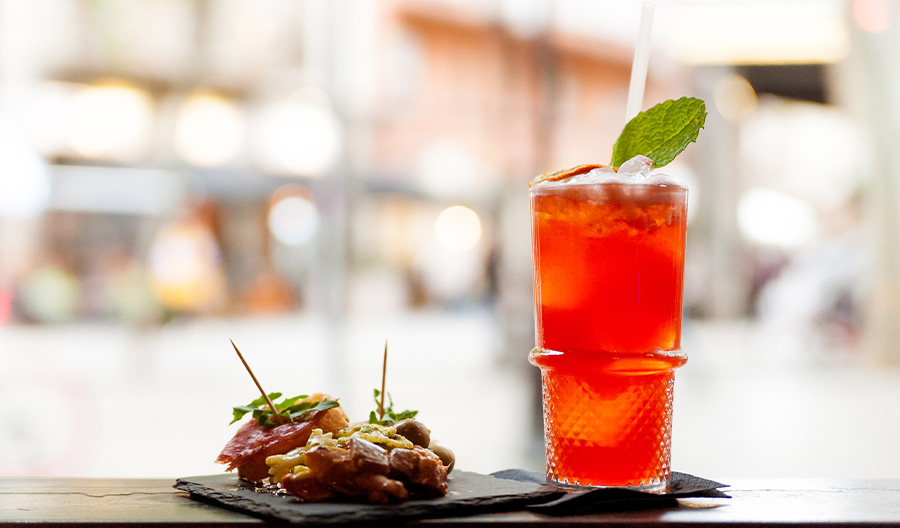A world that represents not only a category of beverages but an act, a state of mind and even a time of day, the all-encompassing aperitivo in Italian (or aperitif in French) is a magical idea that is unique to the great Italian idea of enjoying one another.
What Are Aperitivi?
Typically referring to low-alcohol drinks containing bittersweet liqueurs and/or vermouth, an aperitivo drink is intended to open up one’s palate and stimulate a drinker’s appetite before a meal. The liqueurs used in making these refreshing cocktails are made from closely guarded secret recipes of bitter herbs, roots, spices and citrus macerated in a wine or spirit base then sweetened.
There’s some science behind the appetite-whetting nature of the drinks. Human bodies are naturally programmed to assume that bitter tastes are poisonous, so when a person ingests something bitter, their body naturally reacts by wanting to ingest nutrients to help counteract the effects of the "poison," which is why aperitivo cocktails often preface dinner.
What Is Aperitivo Hour?
Aperitivi are about more than kickstarting one’s appetite. Marissa Huff, the author of “Aperitivo: The Cocktail Culture of Italy,” says that in Italy, aperitivo culture has become woven into the country’s social fabric. It’s an excuse to meet friends before a meal as well as a time to wind down in the early evening and relax with a refreshing drink after work.
And while America’s appreciation for aperitivo culture in all its forms has grown over the past decade, due in part to our changing palates taking on a newfound affinity for bitter flavors, its roots lie in Turin, in northern Italy, where the history of bitters and vermouth began.

Dating back to the late 18th century, as the story goes, an Italian distiller and herbalist invented what’s believed to be the world's first vermouth—a proprietary blend of fortified, aromatized wine that was sweet enough to be sipped rather than consumed for purported medicinal properties, confirms Huff. Within the next century, others began producing bitter liqueurs, such as the founder of the red liqueur which has become one of the world’s most beloved aperitivo liqueurs and aperitivo culture’s gateway drug.
And it was around the same time that the original aperitivo cocktail the Milano-Torino (Mi-To) was conceived, named for the source of its two ingredients: aperitivo liqueur and sweet vermouth . A sparkling variation, the Americano, ensued, which eventually led to the Negroni's birth around 1919. Legend has it that Italian Count Camillo Negroni asked his friend, bartender Forsco Scarselli, to serve him a boozier version of the Americano. Scarselli replaced the Americano’s soda water with gin. The cocktail proved a success and became the center of aperitivo hour.
America Embraces Aperitivi
Over the last decade, Americans have embraced aperitivo culture so much that it’s no longer restricted to the early evening pre-dinner hours. Aperitivo hour has blurred into entire evenings spent sipping and snacking.
And it’s thanks to low-alcohol intoxicants, like the beloved spritz, a sparkling-wine-based cocktail spiked with an aperitivo liqueur plus a splash of fizzy water, that make hours-long drinking sessions enjoyable. In fact, the spritz has proved so popular in the U.S. that it has inspired a growing slate of aperitivi products, including more Italian aperitivi liquors to come stateside.
Like the spritz itself, which is made from just three ingredients, a huge plus for aperitivo cocktails in general is that they’re easy to make. Huff suggests starting with a bottle of aperitivo and a good-quality sweet vermouth. To make the godfather of them all, the Mi-To, mix equal parts aperitivo and sweet vermouth over ice. Or top the drink with soda water and garnish it with an orange slice to make an Americano. Swap gin for soda water, using equal parts sweet vermouth, gin and aperitivo to produce a Negroni. Replace the gin with sparkling wine, and that’s a Negroni Sbaglito. To make an even easier aperitivo cocktail, simply blend vermouth or a bitter liqueur and club soda or sparkling wine. The key, says one Los Angeles Italian bar and restaurant owner: “Don’t overthink it.”

